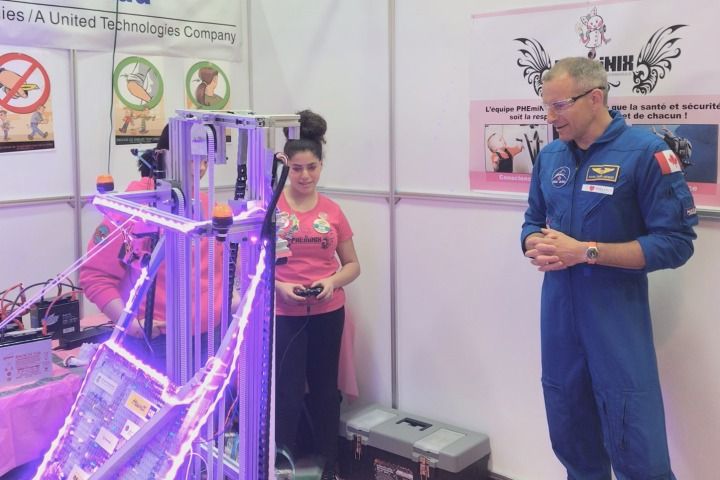What if Uber carried robots instead of people? This startup is working on it.



“To have the opportunity to talk to someone like that and to show what we did, it feels great,” said participant Ruby Novoa Forcier, 18.
Saint-Jacques’ visit was part of the Robotics FIRST (Favoriser l’Inspiration et la Reconnaissance des Sciences et de la Technologie) Quebec competition.
Around 5,000 students from different schools across Quebec, the United States and Europe got the chance to compete at the event.

We know that the universe is expanding, but a strange discrepancy in just how fast that expansion is occurring continues to confound physicists—and make them wonder whether there’s some new, unexplained physics afoot.
For every 3.3 million light years, or one megaparsec, the universe expands around another 70 kilometers per second faster. There are two discrepant measurements of this so-called “Hubble constant.” The light from the most distant parts of the universe reveals an expansion of 68 km/s per megaparsec, while a method taken from extrapolating data from nearby sources reveals a rate of 73 km/s per megaparsec. Scientists can’t explain this discrepancy by chance alone, which means they’re leaving something out, either in their experiments or in the laws of physics. A team of researchers have an idea for another measurement that could help close the gap between these numbers—by measuring how gravity affects the light from distant supernovae.
“If you want to tell the difference between new physics and unknown errors, you need another measurement,” study author Thomas Collett from the University of Portsmouth in the UK told Gizmodo. “If you have measurements that have completely independent methods and they’re all pointing in the same direction, you can robustly believe it’s new physics, not that they’re screwing up in the same way.”
March 2 (UPI) — Forty years after scientists first theoretically predicted the existence of a three-dimensional skyrmion, scientists have observed the particle in the lab.
The particle, observed cold quantum gas, isn’t a normal particle composed of electrons, protons and electrons. It is a quantum particle, the energy signature created by the interactions between a particle and the surrounding system.
In this instance, the quantum particle is a tangled knot of magnetic moments in the quantum gas.
Baidu’s AI research team has developed a nueral network that can mimic a voice with less than a minute long sample. The software can also change the voice into other genders and accents.
The Google of China, Baidu, has just released a white paper showing its latest development in artificial intelligence (AI): a program that can clone voices after analyzing even a seconds-long clip, using a neural network. Not only can the software mimic an input voice, but it can also change it to reflect another gender or even a different accent.


The only difference is that in the case of the new technology Qure.ai is using, the artificial neuro network will be exposed to millions of cases instead of thousands. But can one trust a diagnosis made with the help of machines or AI? Human beings would typically trust another human being over a machine. But Warrier says that that is part and parcel of the diagnosis – human or artificial. Eighty-million chest X-rays happen in India every year, with radiology error rates for chest X-rays at 20–23 per cent. In fact, 19 per cent of lung nodules are missed! So even now if one goes to a trained radiologist, there are chances he can read or make a mistake in the diagnosis. But since the software runs through “millions” of scans instead of thousands as a human might, chances of an error are, in fact, lower. So chances of an error are, if anything, minimised. Secondly, as of now, Qure.ai is not producing a final report but developing a report that is ready for further analysis by a radiologist. “At locations across the country where radiologists are not available, this report can be the one that is physically available. It could go wrong but something is better than nothing,” argues Warrier. In cases where physicians disagree – often happens in cases like interstitial lung disease — the report produced through AI is “consistent and reproducible” and can be relied upon to arrive at a final conclusion. In India, Qure.ai has no competitors, but globally Zebra Medical Vision is the nearest competitor. The software has been adopted and deployed in five centres in Mumbai, Delhi, and Bengaluru. The company is also working with public health programmes in some countries. TB Reach has used it for processing TB cases (chest X-rays) from Nepal and Cameroon. Its solutions are being marketed in North America through its partners EnvoyAI (TeraRecon). According to Warrier, the global sales team of their parent company, Fractal Analytics, is helping them to reach out to health care providers and possible customers in the US and Europe. It may be early days yet, but if the technology and product prove as good as they claim, the benefits for patients will be felt for a long time to come.
As more and more sophisticated robots look and sound more human, it’s going to be tough to distinguish them from people. In the near future, the average person will completely immerse into experiencing their personal humanoid robots as real beings with feelings.
Sophia (meaning “wisdom” in Greek) an advanced AI robot is saying some strange things but what is really going on? This is my theory…check it out.

Scientists at Amherst College and Aalto University have created, for the first time a three-dimensional skyrmion in a quantum gas. The skyrmion was predicted theoretically over 40 years ago, but only now has it been observed experimentally.
In an extremely sparse and cold quantum gas, the physicists have created knots made of the magnetic moments, or spins, of the constituent atoms. The knots exhibit many of the characteristics of ball lightning, which some scientists believe to consist of tangled streams of electric currents. The persistence of such knots could be the reason why ball lightning, a ball of plasma, lives for a surprisingly long time in comparison to a lightning strike. The new results could inspire new ways of keeping plasma intact in a stable ball in fusion reactors.
‘It is remarkable that we could create the synthetic electromagnetic knot, that is, quantum ball lightning, essentially with just two counter-circulating electric currents. Thus, it may be possible that a natural ball lighting could arise in a normal lightning strike,’ says Dr Mikko Möttönen, leader of the theoretical effort at Aalto University.

Sometimes a buzzword gets so overhyped that it deserves some light-hearted mockery. That seems to be the case with “blockchain.” While it’s true that not every industry can benefit from a distributed-ledger technology, the trucking industry most certainly can. In fact, a new consortium called the Blockchain in Transport Alliance (BiTA) is working to apply blockchain to solve some of the most intransigent problems in trucking.
Trucking is a massive industry that affects virtually every American. Trucks move roughly 70 percent of the nation’s freight by weight, according to the American Trucking Association. The Association also found that in 2015, gross freight revenues from trucking were $726.4 billion, representing 81.5 percent of the nation’s freight bill.
Companies hailing from each piece of the trucking supply chain have joined BiTA, including: UPS, Salesforce, McCleod Software, DAT, Don Hummer Trucking and about 1,000 more applicants. [Full disclosure: Our company, Transfix, is also a member.].